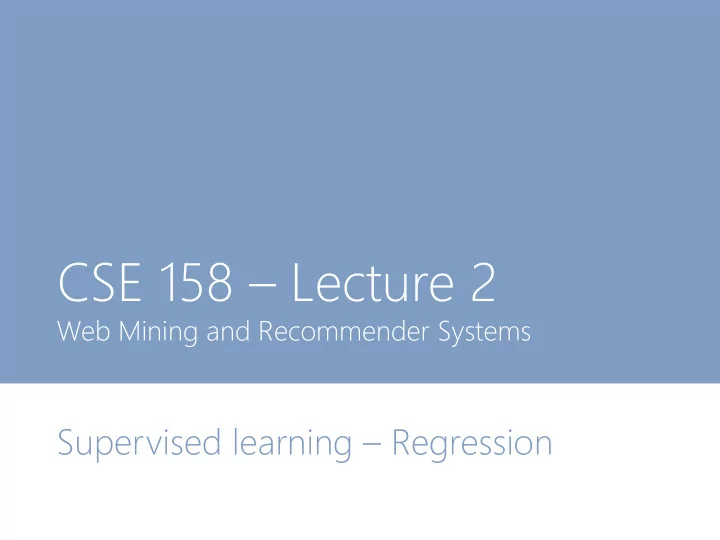

CSE 158 – Lecture 2 Web Mining and Recommender Systems Supervised learning – Regression
Supervised versus unsupervised learning Learning approaches attempt to model data in order to solve a problem Unsupervised learning approaches find patterns/relationships/structure in data, but are not optimized to solve a particular predictive task Supervised learning aims to directly model the relationship between input and output variables, so that the output variables can be predicted accurately given the input
Regression Regression is one of the simplest supervised learning approaches to learn relationships between input variables (features) and output variables (predictions)
Linear regression Linear regression assumes a predictor of the form matrix of features vector of outputs unknowns (labels) (data) (which features are relevant) (or if you prefer)
Linear regression Linear regression assumes a predictor of the form Q: Solve for theta A:
Example 1 How do preferences toward certain beers vary with age?
Example 1 Beers: Ratings/reviews: User profiles:
Example 1 50,000 reviews are available on http://jmcauley.ucsd.edu/cse158/data/beer/beer_50000.json (see course webpage) See also – non-alcoholic beers: http://jmcauley.ucsd.edu/cse158/data/beer/non-alcoholic-beer.json
Example 1 Real-valued features How do preferences toward certain beers vary with age? How about ABV ? (code for all examples is on http://jmcauley.ucsd.edu/cse158/code/week1.py)
Example 1 Preferences vs ABV
Example 2 Categorical features How do beer preferences vary as a function of gender ? (code for all examples is on http://jmcauley.ucsd.edu/cse158/code/week1.py)
Linearly dependent features
Linearly dependent features
Exercise How would you build a feature to represent the month , and the impact it has on people’s rating behavior?
Exercise
What does the data actually look like? Season vs. rating (overall)
CSE 158 – Lecture 2 Web Mining and Recommender Systems Regression Diagnostics
T oday: Regression diagnostics Mean-squared error (MSE)
Regression diagnostics Q: Why MSE (and not mean-absolute- error or something else)
Regression diagnostics
Regression diagnostics Coefficient of determination Q: How low does the MSE have to be before it’s “low enough”? A: It depends! The MSE is proportional to the variance of the data
Regression diagnostics Coefficient of determination (R^2 statistic) Mean: Variance: MSE:
Regression diagnostics Coefficient of determination (R^2 statistic) (FVU = fraction of variance unexplained) FVU(f) = 1 Trivial predictor FVU(f) = 0 Perfect predictor
Regression diagnostics Coefficient of determination (R^2 statistic) R^2 = 0 Trivial predictor R^2 = 1 Perfect predictor
Overfitting Q: But can’t we get an R^2 of 1 (MSE of 0) just by throwing in enough random features? A: Yes! This is why MSE and R^2 should always be evaluated on data that wasn’t used to train the model A good model is one that generalizes to new data
Overfitting When a model performs well on training data but doesn’t generalize, we are said to be overfitting
Overfitting When a model performs well on training data but doesn’t generalize, we are said to be overfitting Q: What can be done to avoid overfitting?
Occam’s razor “Among competing hypotheses, the one with the fewest assumptions should be selected”
Occam’s razor “hypothesis” Q: What is a “complex” versus a “simple” hypothesis?
Occam’s razor
Occam’s razor A1: A “simple” model is one where theta has few non-zero parameters (only a few features are relevant) A2: A “simple” model is one where theta is almost uniform (few features are significantly more relevant than others)
Occam’s razor A1: A “simple” model is one where is small theta has few non-zero parameters A2: A “simple” model is one is small where theta is almost uniform
“Proof”
Regularization Regularization is the process of penalizing model complexity during training MSE (l2) model complexity
Regularization Regularization is the process of penalizing model complexity during training How much should we trade-off accuracy versus complexity?
Optimizing the (regularized) model • Could look for a closed form solution as we did before • Or, we can try to solve using gradient descent
Optimizing the (regularized) model Gradient descent: 1. Initialize at random 2. While (not converged) do All sorts of annoying issues: How to initialize theta? • How to determine when the process has converged? • How to set the step size alpha • These aren’t really the point of this class though
Optimizing the (regularized) model
Optimizing the (regularized) model Gradient descent in scipy: (code for all examples is on http://jmcauley.ucsd.edu/cse158/code/week1.py) (see “ridge regression” in the “ sklearn ” module)
Model selection How much should we trade-off accuracy versus complexity? Each value of lambda generates a different model. Q: How do we select which one is the best?
Model selection How to select which model is best? A1: The one with the lowest training error? A2: The one with the lowest test error? We need a third sample of the data that is not used for training or testing
Model selection A validation set is constructed to “tune” the model’s parameters • Training set: used to optimize the model’s parameters • Test set: used to report how well we expect the model to perform on unseen data • Validation set: used to tune any model parameters that are not directly optimized
Model selection A few “theorems” about training, validation, and test sets • The training error increases as lambda increases • The validation and test error are at least as large as the training error (assuming infinitely large random partitions) • The validation/test error will usually have a “sweet spot” between under - and over-fitting
Model selection
Summary of Week 1: Regression • Linear regression and least-squares • (a little bit of) feature design • Overfitting and regularization • Gradient descent • Training, validation, and testing • Model selection
Homework Homework is available on the course webpage http://cseweb.ucsd.edu/classes/wi17/cse158- a/files/homework1.pdf Please submit it at the beginning of the week 3 lecture (Jan 23) All submissions should be made as pdf files on gradescope
Questions?
Recommend
More recommend